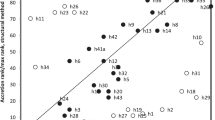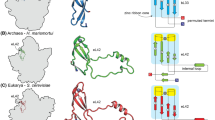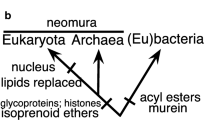Summary
Phylogenetic trees among eukaryotic kingdoms were inferred for large- and small-subunit rRNAs by using a maximum-likelihood method developed by Felsenstein. Although Felsenstein's method assumes equal evolutionary rates for transitions and transversions, this is apparently not the case for these data. Therefore, only transversiontype substitutions were taken into account. The molecules used were large-subunit rRNAs fromXenopus laevis (Animalia), rice (Plantae),Saccharomyces cerevisiae (Fungi),Dictyostelium discoideum (Protista), andPhysarum polycephalum (Protista); and small-subunit rRNAs from maize (Plantae),S. cerevisiae, X. laevis, rat (Animalia), andD. discoideum. Only conservative regions of the nucleotide sequences were considered for this study. In the maximum-likelihood trees for both large- and small-subunit rRNAs, Animalia and Fungi were the most closely related eukaryotic kingdoms, and Plantae is the next most closely related kingdom, although other branching orders among Plantae, Animalia, and Fungi were not excluded by this work. These three eukaryotic kingdoms apparently shared a common ancestor after the divergence of the two species of Protista,D. discoideum andP. polycephalum. These two species of Protista do not form a clade, andP. polycephalum diverged first andD. discoideum second from the line leading to the common ancestor of Plantae, Animalia, and Fungi. The sequence data indicate that a drastic change occurred in the nucleotide sequences of rRNAs during the evolutionary separation between prokaryote and eukaryote.
Similar content being viewed by others
References
Brosius J, Palmer ML, Kennedy PJ, Noller HF (1978) Complete nucleotide sequence of a 16S ribosomal RNA gene fromEscherichia coli. Proc Natl Acad Sci USA 75:4801–4805
Brosius J, Dull TJ, Noller HF (1980) Complete nucleotide sequence of a 23S ribosomal RNA gene fromEscherichia coli. Proc Natl Acad Sci USA 77:201–204
Cloud PE Jr (1968) Atmospheric and hydrospheric evolution on the primitive Earth. Science 160:729–736
Colbert EH (1980) Evolution of the vertebrates: a history of the backboned animals through time, 3rd ed. John Wiley & Sons, New York, pp 86–88
Dickerson R (1971) Structure of cytochrome c and the rates of molecular evolution. J Mol Evol 1:26–45
Felsenstein J (1981) Evolutionary trees from DNA sequences: a maximum likelihood approach. J Mol Evol 17:368–376
Felsenstein J (1982) Numerical methods for inferring evolutionary trees. Q Rev Biol 57:379–404
Felsenstein J (1983) Methods for inferring phylogenies: a statistical view. In: Felsenstein J (ed) Numerical taxonomy. Springer-Verlag, Berlin, pp 315–334
Georgiev OI, Nikolaev N, Hadjiolov AA, Skryabin KG, Zakharyev VM, Bayev AA (1981) The structure of the yeast ribosomal RNA genes. 4. Complete sequence of the 25S rRNA gene fromSaccharomyces cerevisiae. Nucleic Acids Res 9: 6953–6958
Gotoh O (1982) An improved algorithm for matching biological sequences. J Mol Biol 162:705–708
Gray MW, Sankoff D, Cedergren RJ (1984) On the evolutionary descent of organisms and organelles: a global phylogeny based on a highly conserved structural core in small subunit ribosomal RNA. Nucleic Acids Res 12:5837–5852
Hasegawa M (1977) Evolution of transfer ribonucleic acid. In: Kimura M (ed) Molecular evolution and polymorphism. Proceedings of the Second Taniguchi International Symposium on Biophysics. National Institute of Genetics, Mishima, Japan, pp 261–280
Hasegawa M (1978) Evolution of transfer RNA. In: Noda H (ed) Origin of life. Proceedings of the Second International Society for the Study of the Origins of Life Meeting. Center for Academic Publications Japan, Tokyo, pp 495–500
Hasegawa M, Yano T (1984) Phylogeny and classification of Hominoidea as inferred from DNA sequence data. Proc Jpn Acad 60B:389–392
Hasegawa M, Kikuno R, Miyata T, Yano T (1983) The origin and the evolution of cellular organelles. In: Schenk HEA, Schwemmler W (eds) Endocytobiology II. Intracellular space as oligogenetic ecosystem. Walter de Gruyter, Berlin, pp 199–210
Hasegawa M, Yano T, Kishino H (1984) A new molecular clock of mitochondrial DNA and the evolution of hominoids. Proc Jpn Acad 60B:95–98
Hori H, Osawa S (1979) Evolutionary change in 5S RNA secondary structure and a phylogenetic tree of 54 5S RNA species. Proc Natl Acad Sci USA 76:381–385
Kimura M (1968) Evolutionary rate at the molecular level. Nature 217:624–626
Kimura M (1980) A simple method for estimating evolutionary rates of base substitutions through comparative studies of nucleotide sequences. J Mol Evol 16:111–120
Kimura M (1983) The neutral theory of molecular evolution. Cambridge University Press, Cambridge
Kimura M, Ohta T (1973) Eukaryotes-prokaryotes divergence estimated by 5S ribosomal RNA sequences. Nature (New Biol) 243:199–200
Küntzel H, Heidrich M, Piechulla B (1981) Phylogenetic tree derived from bacterial, cytosol and organelle 5S rRNA sequences. Nucleic Acids Res 9:1451–1461
Margulis L (1981) Symbiosis in cell evolution. WH Freeman, San Francisco
Messing J, Carlson J, Hagen G, Rubenstein I, Oleson A (1984) Cloning and sequencing of the ribosomal RNA genes in maize: the 17S region. DNA 3:31–40
Otsuka T, Nomiyama H, Yoshida H, Kukita T, Kuhara S, Sakaki Y (1983) Complete nucleotide sequence of the 26S rRNA gene ofPhysarum polycephalum: its significance in gene evolution. Proc Natl Acad Sci USA 80:3163–3167
Ozaki T, Hoshikawa Y, Iida Y, Iwabuchi M (1984) Sequence analysis of the transcribed and 5′ non-transcribed regions of the ribosomal RNA gene inDictyostelium discoideum. Nucleic Acids Res 12:4171–4184
Rubtsov PM, Mussakhanov MM, Zakharyev VM, Krayev AS, Skryabin KG, Bayev AA (1980) The structure of the yeast ribosomal RNA genes. I. The complete nucleotide sequence of the 18S ribosomal RNA gene fromSaccharomyces cerevisiae. Nucleic Acids Res 8:5779–5794
Salim M, Maden BEH (1981) Nucleotide sequence of theXenopus laevis 18S ribosomal RNA inferred from gene sequence. Nature 291:205–208
Schwartz RM, Dayhoff MO (1978) Origins of prokaryotes, eukaryotes, mitochondria, and chloroplasts. Science 199:395–403
Torczynski R, Bollon AP, Fuke M (1983) The complete nucleotide sequence of the rat 18S ribosomal RNA gene and comparison with the respective yeast and frog genes. Nucleic Acids Res 11:4879–4890
Ware VC, Tague BW, Clark CG, Gourse RL, Brand RC, Gerbi SA (1983) Sequence analysis of 28S ribosomal DNA from the amphibianXenopus laevis. Nucleic Acids Res 11:7795–7817
Whittaker RH (1959) On the broad classification of organisms. Q Rev Biol 34:210–226
Whittaker RH, Margulis L (1978) Protist classification and the kingdoms of organisms. Biosystems 10:3–18
Wilson AC, Carlson SS, White TJ (1977) Biochemical evolution. Annu Rev Biochem 46:573–639
Zuckerkandl E, Pauling L (1965) Molecules as documents of evolutionary history. J Theor Biol 8:357–366
Author information
Authors and Affiliations
Rights and permissions
About this article
Cite this article
Hasegawa, M., Iida, Y., Yano, Ta. et al. Phylogenetic relationships among eukaryotic kingdoms inferred from ribosomal RNA sequences. J Mol Evol 22, 32–38 (1985). https://doi.org/10.1007/BF02105802
Received:
Revised:
Issue Date:
DOI: https://doi.org/10.1007/BF02105802




